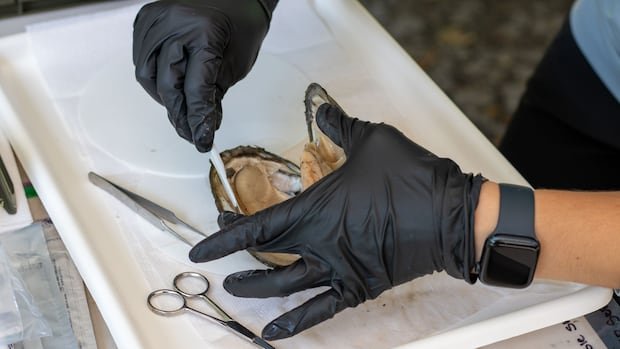A group of scientists is conducting a study on mussels in the Grand River in Brantford, Ontario, aiming to enhance their understanding of how certain chemicals impact the environment. Patty Gillis, an Environment and Climate Change Canada research scientist, and her team, stationed at the Canada Centre for Inland Waters in Burlington, Ontario, focus on analyzing aquatic contaminants.
By utilizing native freshwater mussels as indicators of water quality, the team investigates the distribution and consequences of contaminants. Mussels, known for their stationary behavior, dwell in sediment and filter water through their gills, exposing themselves to water and riverbed pollutants. Gillis mentioned that analyzing a piece of mussel tissue can reveal exposure to substances like metals or pharmaceuticals, affecting their health.
The research team collects samples downstream of Brantford’s wastewater treatment plant to evaluate the impact of individual chemicals and chemical mixtures on various mussel species. This effort is part of the Integrated Chemical Mixtures Project (ICMP), a pilot initiative examining locations in Brantford and Windsor, Ontario, to understand the effects of chemical contaminants on different species.
Mark Hewitt, a Burlington chemist coordinating the ICMP project, emphasized the importance of comprehending complex chemical mixtures and their potential implications for Canadians. The project aims to uncover unknown aspects of chemical mixtures, paving the way to identify solutions for any adverse effects discovered.
The project originated from the acknowledgment of the right to a healthy environment by the federal government, with a collaborative approach employed to assess impacts on human health and the environment. The team plans to compare their findings with other ICMP teams to assess the extent of chemical concentrations in mussel tissues and understand the broader implications.
In addition to studying mussels, other teams are investigating various species like snails, birds, and fish in different locations. Researchers in Sarnia are examining impacts near heavy industrial areas, while Brantford serves as a representative municipality due to its proximity to agricultural regions and a municipal wastewater center.
As part of the project activities, the team set up a mobile lab in Brantford to conduct on-site research. They collected mussels, measured their sizes, collected hemolymph samples, and dissected the specimens for further analysis. Gillis highlighted the importance of studying multiple aspects of mussel health to gather comprehensive data on contaminant accumulation.
Moving forward, the team plans to place mussels upstream and downstream of the wastewater plant and an industrial area to monitor stress levels and chemical accumulation over time. Gillis emphasized the need for a holistic understanding of how different organisms respond to chemicals and expressed the team’s commitment to expanding their research to other locations across Canada.


